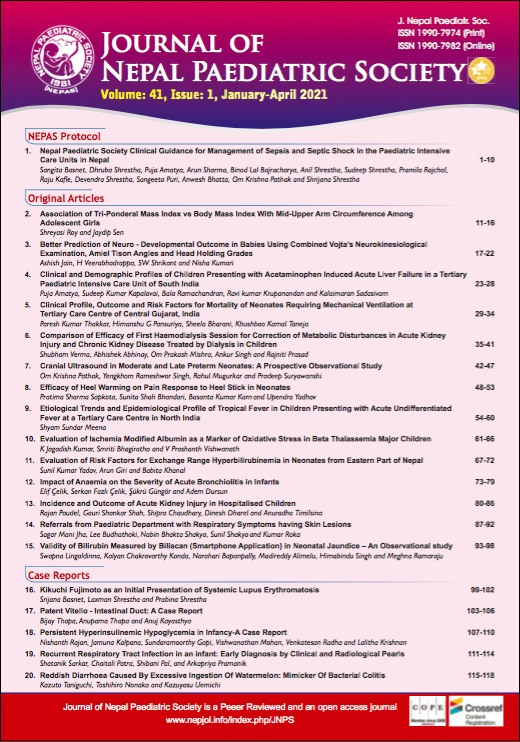Comparison of Efficacy of First Haemodialysis Session for Correction of Metabolic Disturbances in Acute Kidney Injury and Chronic Kidney Disease in Children
DOI:
https://doi.org/10.3126/jnps.v41i1.30825Keywords:
Azotemia, Chronic Kidney Disease, Hemodialysis, Renal replacement therapyAbstract
Introduction: Acute kidney injury and chronic kidney disease present with various complications like electrolyte disturbances, metabolic acidosis and fluid overload in children. The objective of the study was to compare the efficacy of the first session of haemodialysis in children with acute kidney injury stage 3 and chronic kidney disease G5 treated by dialysis for immediate recovery of renal functions in terms of reduction in the level of azotemia, correction of fluid and electrolyte imbalances, metabolic acidosis, and improvement in clinical status.
Methods: This was a cross-sectional comparative observational study conducted on 13 patients of acute kidney injury stage 3 and 46 patients with chronic kidney disease G5, who required haemodialysis. Their clinical assessment, fluid status, renal function tests, electrolyte, bicarbonate were done at admission and completion of the first session of heamodialysis.
Results: The age group of children was six to 16 years (median 11.4 years). There were six males (46%) and seven females (54%) in the acute kidney injury group and 29 (63%) males and 17 (37%) females in chronic kidney disease G5 groups. Sepsis (31%) and glomerulonephritis (31%) were common etiologies detected for acute kidney injury while in chronic kidney disease G5, congenital anomalies of the kidney and the urinary tract were the commonest (50%). There were significant reductions in the levels of serum urea and creatinine and a rise in blood pH, bicarbonate level, and base excess following the first session of haemodialysis in comparison to pre-dialysis values in both AKI and CKD.
Conclusions: The study demonstrated improvement in the clinical parameters and biochemical parameters equally after the first dialysis sessions in both groups. This is one of the effective renal replacement therapy and should be instituted wherever indicated to improve the immediate outcome of the patients.
Downloads
Downloads
Published
How to Cite
Issue
Section
License
Authors who publish with this journal agree to the following terms:
Authors retain copyright and grant the journal right of first publication with the work simultaneously licensed under a Creative Commons Attribution License that allows others to share the work with an acknowledgement of the work's authorship and initial publication in this journal.
Authors are able to enter into separate, additional contractual arrangements for the non-exclusive distribution of the journal's published version of the work (e.g., post it to an institutional repository or publish it in a book), with an acknowledgement of its initial publication in this journal.
Authors are permitted and encouraged to post their work online (e.g., in institutional repositories or on their website) prior to and during the submission process, as it can lead to productive exchanges, as well as earlier and greater citation of published work (See The Effect of Open Access).



